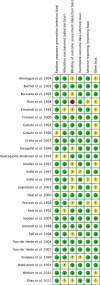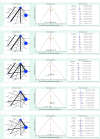NSAIDs for Prophylaxis for Heterotopic Ossification After Total Hip Arthroplasty: A Bayesian Network Meta-analysis
- PMID: 33044630
- PMCID: PMC7819944
- DOI: 10.1007/s00223-020-00763-7
NSAIDs for Prophylaxis for Heterotopic Ossification After Total Hip Arthroplasty: A Bayesian Network Meta-analysis
Abstract
Non-steroidal anti-inflammatory drugs (NSAID) have been recommended to prevent of heterotopic ossification (HO) after total hip arthroplasty (THA), but debates are still ongoing. The present Bayesian network meta-analysis of randomized clinical trials (RCTs) compared all available pathways of NSAID treatment as prophylaxis for HO after THA. The present Bayesian network meta-analysis was conducted according to The PRISMA Extension Statement for Reporting of Systematic Reviews Incorporating Network Meta-analyses of Health Care Interventions guidelines. All randomized clinical trials comparing two or more interventions to prevent HO after THA were considered for analysis. HO was classified according to Brooker. The quality of the methodological assessment was performed through the risk of bias summary tool of the Review Manager Software 5.3 (The Cochrane Collaboration, Copenhagen). The network meta-analysis was performed through a STATA routine for Bayesian hierarchical random-effects model analysis, with log odd ratio (LOR) effect measure. Data from 26 studies (6396 THAs; 58% females) were collected. The mean follow-up was 10.50 ± 5.7 months. ANOVA showed good comparability among mean age and gender (P > 0.5). Celecoxib demonstrated the highest rate of Brooker class 0 (LOR 6.96), followed by diclofenac (LOR 6.94). Naproxen demonstrated the lowest rate of Brooker I HO (LOR 2.82), followed by celecoxib (LOR 3.52). Celecoxib demonstrated lowest rate of Brooker class II HO (LOR 1.66), class III (LOR), and class IV (LOR 0.25). The equation for global linearity detected no statistically significant inconsistency (P > 0.5) in all the comparisons. The present Bayesian network meta-analysis encourages the use of celecoxib as a prophylaxis for HO. These conclusions must be interpreted in light of the limitations of the present study. Future investigations are required to establish more definitely the role of celecoxib.Level of Evidence: I, Bayesian network analysis of RCTs.
Keywords: Heterotopic ossification; NSAID; Total hip arthroplasty.
Conflict of interest statement
Filippo Migliorini, Andromahi Trivellas, Jörg Eschweiler, Arne Driessen, Markus Tingart, and Nicola Maffulli declare that they have no conflicts of interest.
Figures




References
-
- Kan SL, Yang B, Ning GZ, Chen LX, Li YL, Gao SJ, Chen XY, Sun JC, Feng SQ. Nonsteroidal anti-inflammatory drugs as prophylaxis for heterotopic ossification after total hip arthroplasty: a systematic review and meta-analysis. Medicine (Baltimore) 2015;94(18):e828. doi: 10.1097/MD.0000000000000828. - DOI - PMC - PubMed
-
- Lee A, Amin NP (2020) Radiation therapy for heterotopic ossification prophylaxis. In: StatPearls. Treasure Island (FL), - PubMed
Publication types
MeSH terms
Substances
LinkOut - more resources
Full Text Sources
Medical

